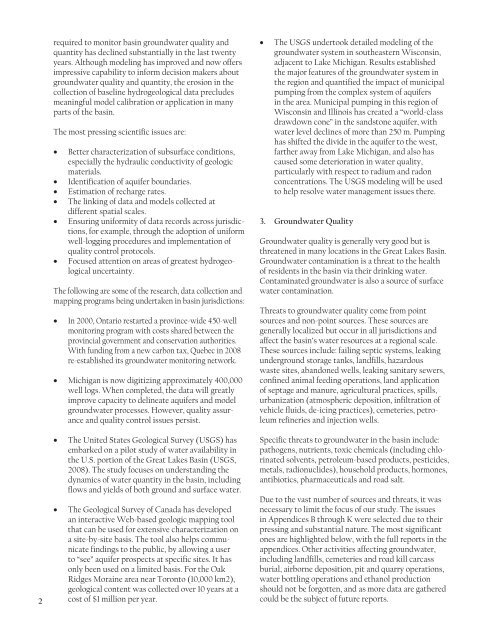Groundwater in the Great Lakes Basin
Groundwater in the Great Lakes Basin
Groundwater in the Great Lakes Basin
You also want an ePaper? Increase the reach of your titles
YUMPU automatically turns print PDFs into web optimized ePapers that Google loves.
2<br />
required to monitor bas<strong>in</strong> groundwater quality and<br />
quantity has decl<strong>in</strong>ed substantially <strong>in</strong> <strong>the</strong> last twenty<br />
years. Although model<strong>in</strong>g has improved and now offers<br />
impressive capability to <strong>in</strong>form decision makers about<br />
groundwater quality and quantity, <strong>the</strong> erosion <strong>in</strong> <strong>the</strong><br />
collection of basel<strong>in</strong>e hydrogeological data precludes<br />
mean<strong>in</strong>gful model calibration or application <strong>in</strong> many<br />
parts of <strong>the</strong> bas<strong>in</strong>.<br />
The most press<strong>in</strong>g scientific issues are:<br />
• Better characterization of subsurface conditions,<br />
especially <strong>the</strong> hydraulic conductivity of geologic<br />
materials.<br />
• Identification of aquifer boundaries.<br />
• Estimation of recharge rates.<br />
• The l<strong>in</strong>k<strong>in</strong>g of data and models collected at<br />
different spatial scales.<br />
• Ensur<strong>in</strong>g uniformity of data records across jurisdictions,<br />
for example, through <strong>the</strong> adoption of uniform<br />
well-logg<strong>in</strong>g procedures and implementation of<br />
quality control protocols.<br />
• Focused attention on areas of greatest hydrogeological<br />
uncerta<strong>in</strong>ty.<br />
The follow<strong>in</strong>g are some of <strong>the</strong> research, data collection and<br />
mapp<strong>in</strong>g programs be<strong>in</strong>g undertaken <strong>in</strong> bas<strong>in</strong> jurisdictions:<br />
• In 2000, Ontario restarted a prov<strong>in</strong>ce-wide 450-well<br />
monitor<strong>in</strong>g program with costs shared between <strong>the</strong><br />
prov<strong>in</strong>cial government and conservation authorities.<br />
With fund<strong>in</strong>g from a new carbon tax, Quebec <strong>in</strong> 2008<br />
re-established its groundwater monitor<strong>in</strong>g network.<br />
• Michigan is now digitiz<strong>in</strong>g approximately 400,000<br />
well logs. When completed, <strong>the</strong> data will greatly<br />
improve capacity to del<strong>in</strong>eate aquifers and model<br />
groundwater processes. However, quality assurance<br />
and quality control issues persist.<br />
• The United States Geological Survey (USGS) has<br />
embarked on a pilot study of water availability <strong>in</strong><br />
<strong>the</strong> U.S. portion of <strong>the</strong> <strong>Great</strong> <strong>Lakes</strong> Bas<strong>in</strong> (USGS,<br />
2008). The study focuses on understand<strong>in</strong>g <strong>the</strong><br />
dynamics of water quantity <strong>in</strong> <strong>the</strong> bas<strong>in</strong>, <strong>in</strong>clud<strong>in</strong>g<br />
flows and yields of both ground and surface water.<br />
• The Geological Survey of Canada has developed<br />
an <strong>in</strong>teractive Web-based geologic mapp<strong>in</strong>g tool<br />
that can be used for extensive characterization on<br />
a site-by-site basis. The tool also helps communicate<br />
f<strong>in</strong>d<strong>in</strong>gs to <strong>the</strong> public, by allow<strong>in</strong>g a user<br />
to “see” aquifer prospects at specific sites. It has<br />
only been used on a limited basis. For <strong>the</strong> Oak<br />
Ridges Mora<strong>in</strong>e area near Toronto (10,000 km2),<br />
geological content was collected over 10 years at a<br />
cost of $1 million per year.<br />
• The USGS undertook detailed model<strong>in</strong>g of <strong>the</strong><br />
groundwater system <strong>in</strong> sou<strong>the</strong>astern Wiscons<strong>in</strong>,<br />
adjacent to Lake Michigan. Results established<br />
<strong>the</strong> major features of <strong>the</strong> groundwater system <strong>in</strong><br />
<strong>the</strong> region and quantified <strong>the</strong> impact of municipal<br />
pump<strong>in</strong>g from <strong>the</strong> complex system of aquifers<br />
<strong>in</strong> <strong>the</strong> area. Municipal pump<strong>in</strong>g <strong>in</strong> this region of<br />
Wiscons<strong>in</strong> and Ill<strong>in</strong>ois has created a “world-class<br />
drawdown cone” <strong>in</strong> <strong>the</strong> sandstone aquifer, with<br />
water level decl<strong>in</strong>es of more than 250 m. Pump<strong>in</strong>g<br />
has shifted <strong>the</strong> divide <strong>in</strong> <strong>the</strong> aquifer to <strong>the</strong> west,<br />
far<strong>the</strong>r away from Lake Michigan, and also has<br />
caused some deterioration <strong>in</strong> water quality,<br />
particularly with respect to radium and radon<br />
concentrations. The USGS model<strong>in</strong>g will be used<br />
to help resolve water management issues <strong>the</strong>re.<br />
3. <strong>Groundwater</strong> Quality<br />
<strong>Groundwater</strong> quality is generally very good but is<br />
threatened <strong>in</strong> many locations <strong>in</strong> <strong>the</strong> <strong>Great</strong> <strong>Lakes</strong> Bas<strong>in</strong>.<br />
<strong>Groundwater</strong> contam<strong>in</strong>ation is a threat to <strong>the</strong> health<br />
of residents <strong>in</strong> <strong>the</strong> bas<strong>in</strong> via <strong>the</strong>ir dr<strong>in</strong>k<strong>in</strong>g water.<br />
Contam<strong>in</strong>ated groundwater is also a source of surface<br />
water contam<strong>in</strong>ation.<br />
Threats to groundwater quality come from po<strong>in</strong>t<br />
sources and non-po<strong>in</strong>t sources. These sources are<br />
generally localized but occur <strong>in</strong> all jurisdictions and<br />
affect <strong>the</strong> bas<strong>in</strong>’s water resources at a regional scale.<br />
These sources <strong>in</strong>clude: fail<strong>in</strong>g septic systems, leak<strong>in</strong>g<br />
underground storage tanks, landfills, hazardous<br />
waste sites, abandoned wells, leak<strong>in</strong>g sanitary sewers,<br />
conf<strong>in</strong>ed animal feed<strong>in</strong>g operations, land application<br />
of septage and manure, agricultural practices, spills,<br />
urbanization (atmospheric deposition, <strong>in</strong>filtration of<br />
vehicle fluids, de-ic<strong>in</strong>g practices), cemeteries, petroleum<br />
ref<strong>in</strong>eries and <strong>in</strong>jection wells.<br />
Specific threats to groundwater <strong>in</strong> <strong>the</strong> bas<strong>in</strong> <strong>in</strong>clude:<br />
pathogens, nutrients, toxic chemicals (<strong>in</strong>clud<strong>in</strong>g chlor<strong>in</strong>ated<br />
solvents, petroleum-based products, pesticides,<br />
metals, radionuclides), household products, hormones,<br />
antibiotics, pharmaceuticals and road salt.<br />
Due to <strong>the</strong> vast number of sources and threats, it was<br />
necessary to limit <strong>the</strong> focus of our study. The issues<br />
<strong>in</strong> Appendices B through K were selected due to <strong>the</strong>ir<br />
press<strong>in</strong>g and substantial nature. The most significant<br />
ones are highlighted below, with <strong>the</strong> full reports <strong>in</strong> <strong>the</strong><br />
appendices. O<strong>the</strong>r activities affect<strong>in</strong>g groundwater,<br />
<strong>in</strong>clud<strong>in</strong>g landfills, cemeteries and road kill carcass<br />
burial, airborne deposition, pit and quarry operations,<br />
water bottl<strong>in</strong>g operations and ethanol production<br />
should not be forgotten, and as more data are ga<strong>the</strong>red<br />
could be <strong>the</strong> subject of future reports.

















